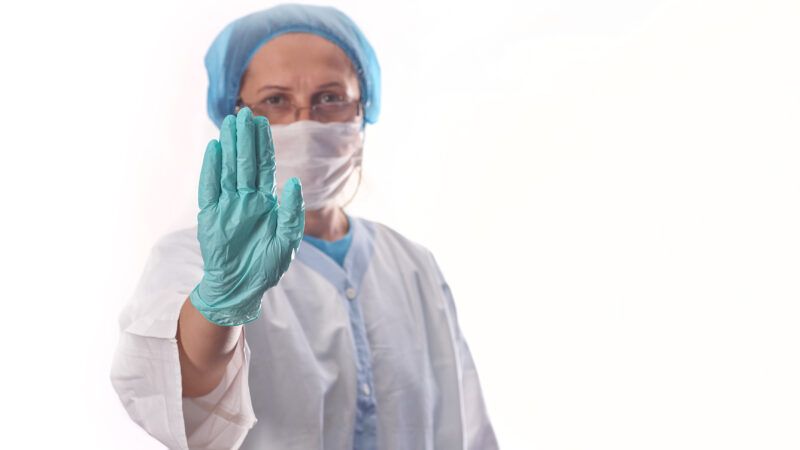How the Government Timidly Stood in the Way of COVID-Fighting Innovations
Without the feds in the way, we could have rolled out at-home diagnostic testing, set up human challenge trials, approved vaccines sooner, and vaccinated Americans more quickly.

"Are We Much Too Timid in the Way We Fight Covid-19?" asks New York Times columnist Ezra Klein in today's paper. When it comes to developing and distributing tests and vaccines, we have indeed been too timid—not by choice, but because bureaucrats forced us to be.
The first big bureaucratic failure occurred when the Centers for Disease Control and Prevention (CDC) insisted that state public health agencies use a COVID-19 diagnostic test it developed. For about two months, the government forbade biotech companies and academic laboratories from developing and deploying their own tests. But the CDC test was so flawed that it was useless, and the undetected virus spread widely. Contrast that with the public health authorities in South Korea, who worked with private companies to develop and deploy a COVID-19 diagnostic test within a week after the first 4 cases had been detected.
In March 2020, I urged that the Food and Drug Administration (FDA) get out of the way of at-home COVID-19 testing, which private companies were already developing that month. Instead, the agency ordered them to stop and to destroy the patient samples they had collected. It took the FDA until December to finally get around to approving a supposedly over-the-counter at-home COVID-19 antigen diagnostic test—and it's still unavailable to consumers. And yesterday, that's right, yesterday, the FDA approved two more over-the-counter at-home COVID-19 diagnostic tests.
Thanks to the unprecedentedly rapid roll out of various COVID-19 vaccines, the end of the pandemic is in sight, at least for rich countries like the United States. On the positive side, these clinical trials were developed in less than a year—compared to an average of 10.7 years for earlier vaccines. But the rollout could have been so much faster.
Moderna devised the recipe for its COVID-19 vaccine in just two days, and the company injected it into the first volunteer on March 16, 2020. But FDA bureaucrats insisted that the vaccine makers follow the usual path of Phases 1, 2, and 3 clinical trials for testing safety and efficacy. It would have made much more sense to authorize human challenge trials, in which young volunteers are given either the vaccine candidate or a placebo and then exposed to the virus to see if the shot works. Instead of waiting around for the virus to find both vaccinated and unvaccinated folks in the wild, as researchers do in regular Phase 3 trials, this would speed things up by bringing the virus to the volunteers.
If this had been done, we could have known by last summer how amazingly effective the new vaccines are. Keep in mind that by September 1, 2020, some 6.4 million and 190,000 Americans had been diagnosed and died respectively of the disease. Now the disease has been diagnosed in some 31 million Americans and has killed 565,000.
On April 29, 2020 the Trump administration unveiled Operation Warp Speed, with a goal of making 300 million doses of effective COVID-19 vaccines available by January 2021. On May 4, George Mason University economist Alex Tabarrok and colleagues proposed that the U.S. government "go big" and commit $70 billion to encourage pharmaceutical companies to build out facilities for manufacturing COVID-19 vaccines. Ultimately, the Trump administration allocated about $13 billion to Operation Warp Speed. That's some of the best money that the U.S. government has ever spent.
But again Americans faced unnecessary limits. Back in December, the clinical trial results from the Pfizer/BioNTech and Moderna vaccines showed that they were about 90 percent effective at preventing COVID-19 after just one dose. Given those data, some of us asked, why use two doses when one dose works almost as well? By delaying the second doses for the vaccines, we could double the number of Americans protected from the severe COVID-19 infections.
So far, nearly 100 million Americans have received at least one dose of the two-dose vaccines and 56 million are fully vaccinated. Had the second doses been delayed, 156 million Americans could now have been vaccinated—nearly 50 percent of the population.
Even more Americans could have been vaccinated by now if the FDA would accept the safety and efficacy evaluations of brother bureaucracies such as the United Kingdom's Medicines and Healthcare Products Regulatory Agency. Britain's regulators approved the Oxford/AstraZeneca vaccine three months ago, on December 30. The U.S. is sitting on a stockpile of around 30 million doses of that vaccine. Nevertheless, the FDA has yet to approve it, despite clinical trial results indicating that it is 76 percent effective against symptomatic COVID-19 and 100 percent effective against hospitalization and deaths.
So far, the pandemic has brought us tens of millions of infections, nearly a million hospitalizations, and 565,000 deaths. Economically, millions of jobs were lost, the economy shrank by 3.5 percent, and the U.S. government has wracked up trillions more in debt. Speedier rollouts of both testing and vaccines could have substantially ameliorated these losses. But timid bureaucrats stood in our way.


Show Comments (30)